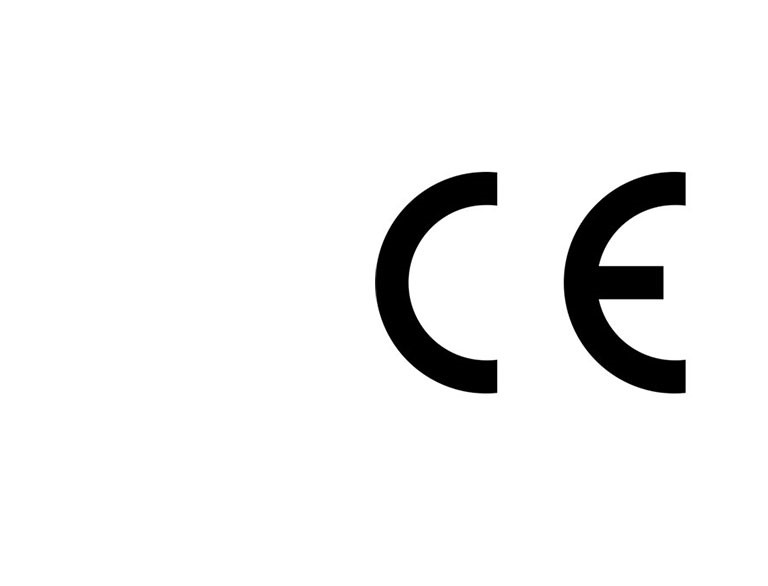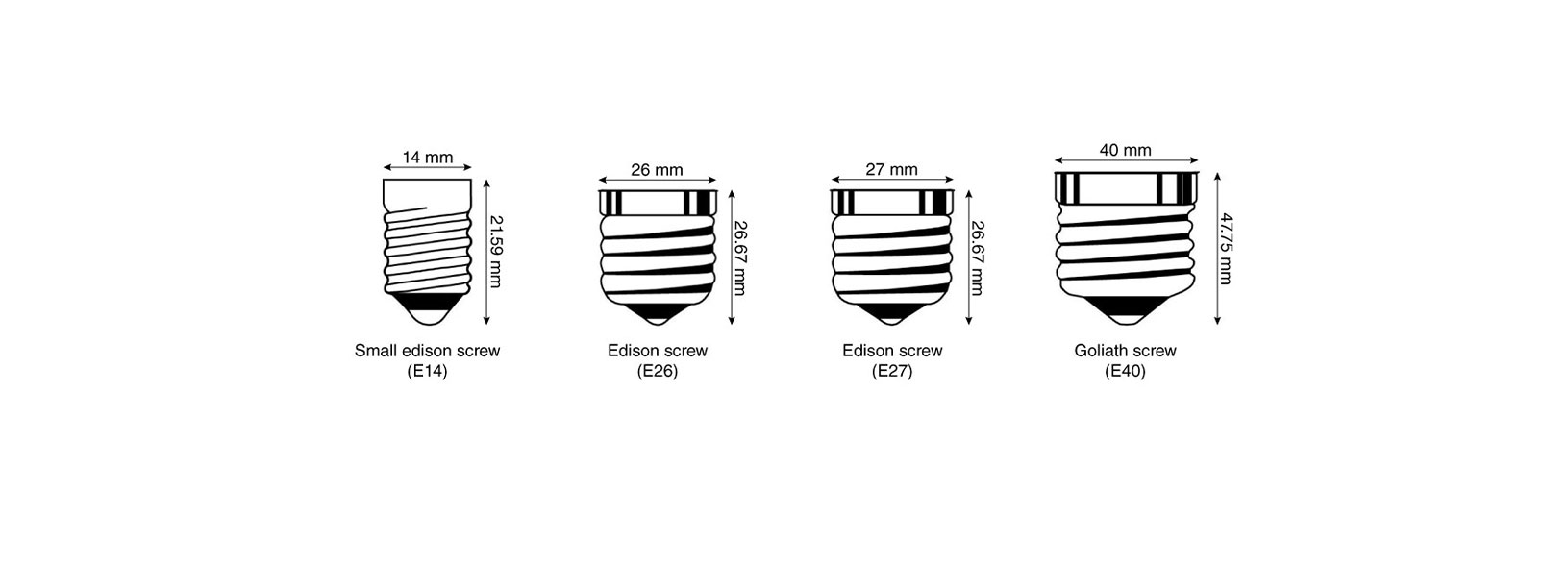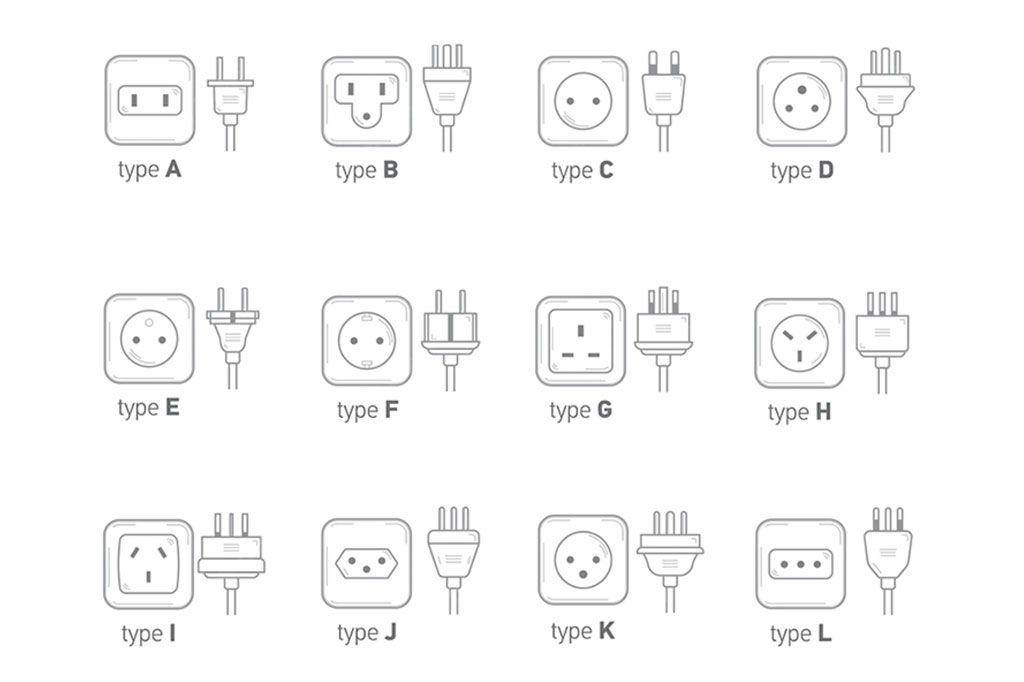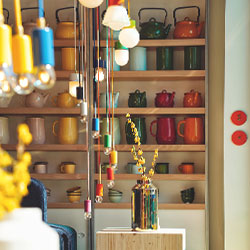▹ CE Label
The CE Label
The letters CE on a zangra product indicate that the product meets the European Union's safety standards and other requirements for sale.
The product meets the standards for it to be sold in the European Union (plus Switzerland, Lichtenstein, Norway and Iceland). It represents the French phrase "Conformité Européenne", which indicates conformity with European law.
The CE label is required by law in order to show that the product meets European health, safety and environmental standards.
This certification is generally not recognized in the United States, which has its own certification standards of product safety (UL-listed).
Feel free to contact our customer service by filling in our »contact form«.

▹ E26 versus E27
E26 vs E27, what's the difference?
E26 stands for 26 mm and the E27 for 27 mm in diameter.
These two standards are interchangeable, meaning a US E26 will fit in a European E27 base, and E27 will fit in a E26 base. The only difference is the voltage (for light bulbs).
In fact there is only 1 mm difference between the threads of E26 and E27, so they are virtually identical. Still, it's important to buy the correct bulb certified for use in your country. This is because each country and region of the world have different certifications.
An easy reference for which light bulb type is used in major markets is as follows:
- United States - E26 Edison Screw
- Canada - E26 Edison Screw
- Japan & Taiwan - E26 Edison Screw
- Australia - E27 Edison Screw (or B22 Bayonet Cap)
- Europe - E27 Edison Screw
- United Kingdom - E27 Edison Screw (or B22 Bayonet Cap)
Here is a complete list of countries with the type of standard Edison Screw used.
The following countries use E26 bulbs
Anguilla, Aruba, Bahamas, Barbados, Belize, Bermuda, Canada, Cayman Islands, Colombia, Costa Rica, Cuba, Dominican Republic, Ecuador, El Salvador, Guatemala, Haiti, Honduras, Jamaica, Japan, Libya, Mexico, Nicaragua, Panama, Taiwan, Trinidad and Tobago, United States, Venezuela and British Virgin Islands.
The following countries use E27 bulbs
Afghanistan, Aland Islands, Albania, Algeria, Andorra, Angola, Antigua and Barbuda, Argentina, Armenia, Australia, Austria, Azerbaijan, Bahrain, Bangladesh, Belarus, Belgium, Benin, Bhutan, Bolivia, Bosnia And Herzegovina, Botswana, Bouvet Island, Brazil, British Indian Ocean Territory, Brunei, Bulgaria, Burkina Faso, Burma, Burundi, Cambodia, Cameroon, Cape Verde, Central African Republic, Chad, Chile, China, Christmas Island, Cocos (Keeling) Islands, Comoros, Congo, The Democratic Republic Of The Congo, Cook Islands, Côte d'Ivoire, Croatia, Cyprus, Czech Republic, Denmark, Djibouti, Dominica, Egypt, Equatorial Guinea, Eritrea, Estonia, Ethiopia, Falkland Islands (Malvinas), Faroe Islands, Fiji, Finland, France, French Guiana, French Polynesia, French Southern Territories, Gabon, Gambia, Georgia, Germany, Ghana, Gibraltar, Greece, Greenland, Grenada, Guadeloupe, Guernsey, Guinea, Guinea Bissau, Guyana, Heard Island And Mcdonald Islands, Holy See (Vatican City State), Hong Kong, Hungary, Iceland, India, Indonesia, Islamic Republic Of Iran, Iraq, Ireland, Isle Of Man, Israel, Italy, Jersey, Jordan, Kazakhstan, Kenya, Kiribati, Korea, Kosovo, Kuwait, Kyrgyzstan, Lao People's Democratic Republic, Latvia, Lebanon, Lesotho, Liberia, Liechtenstein, Lithuania, Luxembourg, Macao, Macedonia, The Republic Of, Madagascar, Malawi, Malaysia, Maldives, Mali, Malta, Martinique, Mauritania, Mauritius, Mayotte, Republic of Moldova, Monaco, Mongolia, Montenegro, Montserrat, Morocco, Mozambique, Myanmar, Namibia, Nauru, Nepal, Netherlands, Netherlands Antilles, New Caledonia, New Zealand, Niger, Nigeria, Niue, Norfolk Island, Norway, Oman, Pakistan, Palestinian Territory, Occupied, Papua New Guinea, Paraguay, Peru, Philippines, Pitcairn, Poland, Portugal, Qatar, Reunion, Romania, Russia, Rwanda, Saint Barthélemy, Saint Helena, Saint Kitts And Nevis, Saint Lucia, Saint Martin, Saint Pierre And Miquelon, Samoa, San Marino, Sao Tome And Principe, Saudi Arabia, Senegal, Serbia, Seychelles, Sierra Leone, Singapore, Slovakia, Slovenia, Solomon Islands, Somalia, South Africa, South Georgia And The South Sandwich Islands, South Korea, Spain, Sri Lanka, St. Vincent, Sudan, Suriname, Svalbard And Jan Mayen, Swaziland, Sweden, Switzerland, Syria, Tajikistan, (United Republic Of) Tanzania, Thailand, Timor Leste, Togo, Tokelau, Tonga, Tunisia, Turkey, Turkmenistan, Turks And Caicos Islands, Tuvalu, Uganda, Ukraine, United Arab Emirates, United Kingdom, Uruguay, Uzbekistan, Vanuatu, Vietnam, Wallis And Futuna, Western Sahara, Yemen, Zambia, Zimbabwe
Feel free to contact our customer service by filling in our »contact form«.

▹ damp-rated lights for bathroom
Why is there an IP value on a light fitting?
All light fittings are classified according to their IP value. These IP values (International Protection or Ingress Protection) indicate the degree of protection of the light fitting against dust and moisture. The IP value consists of two digits: the first digit indicates the level of protection against dust; the second, the level of protection against moisture. The higher the IP value, the higher the protection.
It is important that lamps in the bathroom are safe, as moisture and electricity obviously do not mix.
What does the IP value mean on a light fitting?
1) The first number after the letters IP indicates the degree to which the device is protected against dust
IP0x – no protection
IP1x – protected against a solid object greater than 50 mm such as a hand
IP2x – protected against a solid object greater than 12.5 mm such as a finger
IP3x – protected against a solid object greater than 2.5 mm such as a screwdriver
IP4x – protected against a solid object greater than 1 mm
IP5x – Dust protected
IP6x – Dust tight.
2) The second digit after the letters IP indicates protection against moisture
IPx0 – no protection
IPx1 – protected against vertical falling of drops.
IPx2 – protected against vertical falling drops of water with enclosure tilted up to 15° from the vertical
IPx3 – protected against sprays of water up to 60 degrees from the vertical (rain for example)
IPx4 – protected against water splashes from all directions
IPx5 – protected against jets of water (from a shower for example)
IPx6 – protected against powerful jets of water
IPx7 – watertight against the effects of immersion in water (30min)
IPx8 – watertight against the effects of immersion in water (for long periods of time, for example in a swimming pool)
zangra has grouped all lamps that are IP44+ or for outdoor use in "this section".
You can divide a bathroom into a number of zones (European regulations). Each zone has its own IP value.
The illustration below shows the different zones in the bathroom.
Which IP value belongs to which zone in a bathroom?
Zone 0 min. IP 67
Zone 1 min. IP 65
Zone 2 min. IP 44
Zone 3 (anywhere outside zones 0, 1 and 2): There are no special IP-requirements in this zone.
TIP: just above the shower we advise you to use an IP65 because the lighting here could come in direct contact with water.
It is recommended to install sockets only in zone number 3.
Feel free to contact our customer service by filling in our »contact form«.

▹ dimmable or non-dimmable?
Is my light fixture dimmable?
What makes a light fixture dimmable is the dimmer controlling it and the light bulb. So it is the light bulb that determines whether you can dim or not (and not the fixture).
It’s important that the dimmer matches up to the light bulb technology in order for it to work properly, because not all bulbs are dimmable, and not all dimmers dim all bulbs.
These are the most common light sources:
* halogen bulbs (dimmable)
* incandescent bulbs (dimmable)
* energy saving lamps (non-dimmable)
* LED lamps (there are dimmable and non-dimmable LED bulbs).
Can you dim any LED bulb?
In a word, no. Dimmable LED bulbs and their non-dimmable counterparts use entirely different componentry, so putting a non-dimmable bulb on a dimmable circuit will not work. This isn’t true of the reverse though; a dimmable bulb will work just fine on a non-dimmable circuit, it just won’t dim…
LEDs that are dimmable are typically labelled as such on the box. If it isn't labelled as dimmable, it's safe to assume it isn’t.
Use only dimmers designed for LED to dim LED light bulbs!
Please note that dimmable LED lamps currently have a lower dimming range than a filament lamp. LEDs currently dim down to about 10% of the total light output whereas filaments may go down to 1-2%.
Your light bulbs flicker and hum? Your light bulbs are not dimming correctly?
That does not mean that the LED bulbs are defective or that the dimmer is broken!
How is this possible?
- a non-dimmable lamp is used. (non-dimmable bulbs will NOT work in dimming circuits)
- the dimmer is not designed for LED lamps (use only a compatible dimmer)
- the power load of the LED lamp is below the minimum required by the dimmer.
- the dimmer is incompatible with the LED lamp technology
- different type of LED lamps are used in the same dimming circuit. The dimmer probably won’t be capable of providing a common signal to each light source. (Ensure that all your bulbs are of the same type and from the same manufacturer).
Can dimmable LED lighting be controlled using a standard dimmer?
Standard dimmers will be under loaded in most LED applications, exacerbating flickering and strobing effects, which, in turn, can drastically shorten lamp life. Standard dimmers are also not equipped to exploit the full brightness range, resulting in a disappointing user experience. Standard dimmers are made to work in high-power circuits and have a mechanism that allows them to dim light from a traditional filament by altering the voltage. But LED lamps have a different functionality. They operate in much lower voltages. So use only dimmers designed for LED lamps, because the dimmers for halogen and incandescent light bulbs cannot ‘read’ the low loading of a LED lamp.
How to select the proper dimmer for LED bulbs?
There are numerous types of dimmer switch available, but by far the most popular are leading edge and trailing edge phase-cut dimmers. Without getting too technical, traditional leading-edge dimmers are designed specifically for high-power circuits and dimming traditional filament bulbs where a variation in voltage is required. Dimming LED bulbs is a lot more complicated, particularly considering the inclusion of an LED driver in the design. Most LED bulbs require a trailing-edge mechanism to work effectively. Traditional dimmer switches are designed to work on lighting circuits with a high load. In a lot of cases LED bulbs won't work with traditional dimmer switches because the load on the circuit is not high enough to meet the minimum load on the dimmer switch. A typical trailing edge dimmer has a minimum load of around 50-60 watts. This is fine when you're dimming 50 watt halogens, but not when you're using 6 watt LED bulbs. If the load on the circuit isn't high enough, the dimmer won't work. Newer, leading edge dimmer switches, are designed with a lower minimum load which helps address this problem.
The load can be calculated by taking the wattage of each bulb and multiplying it by the number of bulbs on the circuit. For example, if you have 10 bulbs, 5 watts each, the load on the circuit will be 50 watts.
Can dimming LED lamps save more energy?
Yes! Dimmed LED lights mean a reduction in energy consumption.
Which dimmers does zangra sell?
»Here« you can find our full range of dimmers.

▹ appliance classes
In the electrical appliance manufacturing industry, the following protection classes are defined and used to differentiate between the protective-earth connection requirements of devices.
Class I
These appliances must be connected to electrical earth (US: ground) by a separate earth conductor (green/yellow colour in most countries, green in the US, Canada and Japan). Earthing is achieved through a 3-core mains cable. The basic requirement is that no single fault can result in exposure to dangerous voltage which may cause an electric shock, and that, in the event of a problem, the power will automatically switch off.
Class II
A Class II or double insulated electrical appliance is one which has been designed in such a way that it does not require a safety connection to electrical earth (ground).
The basic requirement is that no single fault can result in exposure to dangerous voltage which may cause an electric shock, and that this is achieved without relying on an earthed metal casing. This is usually achieved at least in part by having at least two layers of insulating material between live parts and the user, or by using reinforced insulation.
In Europe, a double insulated appliance must be labelled Class II or double insulated or bear the double insulation symbol (a square inside another square).

▹ different types of plugs and outlets
What kind of plugs and outlets are used in which countries?
There are currently 15 different kinds of electrical plugs and outlets for domestic applications. Each kind has been assigned a letter of the alphabet, starting with A and ending with O.
Type A plugs & outlets
A type A plug has 2 parallel prongs and is used in North and Central America, and Japan.
- 2 pins
- not grounded
- 15 A
- almost always 100 – 127 V
- outlet compatible with type A plugs
Type B plugs & outlets
This plug has a U-shaped or round ground pin. The official name of this plug is NEMA 5-15 in the USA and CS22.2, n° 42 in Canada.
- 3 pins
- grounded
- 15 A
- almost always 100 – 127 V
- outlet compatible with type A and type B plugs
Type C plugs & outlets
Type C outlets and plugs are used in every European countries, except the United Kingdom, Ireland, Cyprus and Malta. This plug is called Europlug and its official name is CEE 7/16.
Widely used in Europe and some regions of South America and Asia.
- 2 pins
- not grounded
- 2.5 A, 10 A and 16 A
- almost always 220 – 240 V
- outlet compatible with type C plug
Type D plugs & outlets
Type D plugs and outlets are almost exclusively used in India and Nepal.
- 3 pins
- grounded
- 5 A
- 220 – 240 V
- outlet compatible with type D plug (partial compatibilty with types C, E and F – danger!)
Type E plugs & outlets
Type E outlets are very similar to type C, but with an earth pin.
Mainly used in Belgium, France, Poland, Slovakia, Czech Republic, Tunisia and Morocco.
- 2 pins
- grounded
- 16 A
- 220 – 240 V
- outlet compatible with type C, E and F plugs
Type F plugs & outlets
Type F outlets and plugs are used in the Netherlands, Germany, Austria, Sweden, Norway, Finland, Portugal, Spain, Turkey and Eastern Europe. Type F plug is also called CEE 7/4 or Schuko plug. Schuko is the acronym of Schutzkontakt, which in German means protection contact or safety contact. This plug was originally designed in Germany. It is not perfectly round as it has two plastic notches on the left and right side. A CEE 7/7 plug can be plugged into type E and type F outlet.
Used in Russia and nearly everywhere in Europe, except United Kingdom and Ireland.
- 2 pins
- grounded
- 16 A
- 220 – 240 V
- outlet compatible with type C, E and F plugs
Type G plugs & outlets
British outlets have three rectangular holes and are known as BS 1363. Each outlet must be grounded and they almost always have a switch for additionnal safety. Type G outlets also have a child protection device to prevent accidents. The earth pin is slightly longer than the other two pins and when a plug is plugged into an outlet, the earth pin pushes back a shutter that opens the two other holes and allows for the insertion of the plug. As type C plugs do not have such an earth pin, it is almost impossible to insert a Europlug in a type G outlet, unless you stick a pointy object in the earth hole.
Mainly used in United Kingdom, Ireland, Malta, Malaysia, Singapore and the Arabian peninsula.
- 3 pins
- grounded
- 13 A
- 220 – 240 V
- outlet compatible with type G plugs
Type H plugs & outlets
Type H plugs have an earth pin and two other V-shaped pins.
Used in Israel and Palestine.
- 3 pins
- grounded
- 16 A
- 220 – 240 V
- outlet compatible with type C and H plugs (partial compatibilty with types E and F – danger!)
Type I plugs & outlets
This grounded plug has two V-shaped thick flack pins.
Mainly used in Australia, New Zealand, China and Argentina.
- 2 or 3 pins
- 2 pins: ungrounded / 3 pins: grounded
- 10 A
- 220 – 240 V
- outlet compatible with type I plugs
Type J plugs & outlets
Switzerland has its own standard (SEV 1011), similar to type C, except that Swiss plugs also have an earth pin in the middle.
Almost exclusively used in Switzerland and Liechtenstein.
- 3 pins
- grounded
- 10 A
- 220 – 240 V
- outlet compatible with type C and J plugs
Type K plugs & outlets
Denmark has its own standard (DS 60884-2-D1). Unlike type E system, the earth pin is not mounted in the outlet, but is on the plug.
Almost exclusively used in Denmark and Greenland.
- 3 pins
- grounded
- 16 A
- 220 – 240 V
- outlet compatible with type C and K plugs (partial compatibilty with types E and F – danger!)
Type L plugs & outlets
Type L system is almost exclusively used in Italy, Chile and Uruguay, sometimes also in North Africa.
- 3 pins
- grounded
- 10 A and 16 A
- 220 – 240 V
- 10 A outlet compatible with types C and L plugs (10 A version)
- 16 A outlet compatible with type L plugs (16 A version)
Type M plugs & outlets
Type M is almost exclusively used in South Africa, Swaziland and Lesotho. Type M plug is similar to type D, with its three prongs forming a triangle, but they are not compatible.
Mainly used in South Africa.
- 3 pins
- grounded
- 15 A
- 220 – 240 V
- outlet compatible with type M plugs
Type N plugs & outlets
Type N consists of two pins and one earth pin that form a triangle. Type N is the most compact, robust and safest system in the world.
Used in Brazil and South Africa.
- 3 pins
- grounded
- 10 A, 16 A and 20 A
- 100 – 240 V
- outlet compatible with types C and N plugs
Type O plugs & outlets
Type O is used only in Thailand.
- 3 pins
- grounded
- 16 A
- 220 – 240 V
- outlet compatible with types C and O plugs (partial compatibilty with types E and F – danger!)

▹ how to choose a textile cable ?
[DESC13]
[DESC14]
▹ are all products in stock?
Are all products on the website in stock?
If you can add a product to your shopping basket with, for example, the status "SHIPPING WITHIN 2-3 DAYS", this means that the product is in stock.
Products with a longer shipping time (e.g. SHIPPING IN 3-4 WEEKS), are products that we do not have in stock and are still in production.
You can find this information on each product page and also in your shopping basket.
Our customer service agents don't have any more information regarding product availability other than the information on the website.
▹ back in stock notification
Can zangra notify me when a product that is out of stock is back in stock?
If a product is out of stock, we can notify you as soon as it is back in stock. On the product page, you will find an option to be notified when the product is available again. Simply enter your email address and click "NOTIFY ME".
An automatic email will be sent to you as soon as the product is back in stock.
▹ spare parts
I want to buy a replacement part. Where can I find your replacement parts?
Have you lost or damaged a part of one of our products? No problem! You can find our "spare parts" here.
You have broken a glass shade of one of the lamps?
You can find all the "replacement glass" here. The globes are divided by size.

